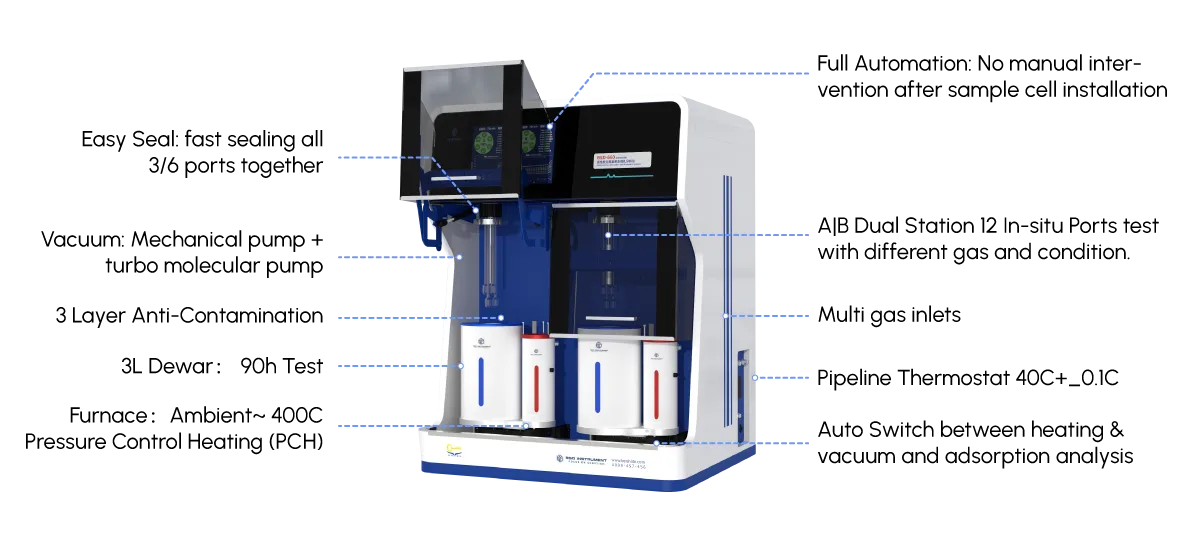Home / Blog / Exploring the Impact of Surface Area & Porosity on Material Properties
Exploring the Impact of Surface Area & Porosity on Material Properties
02 9 月, 2025From: BSD Instrument

Surface Area & Porosity are two fundamental structural characteristics that exert a profound influence on the physical, chemical, and mechanical properties of materials. From catalysts and adsorbents in environmental engineering to biomedical implants and energy storage devices, the manipulation of these two parameters has become a core strategy for tailoring material performance to meet specific application demands. This article systematically examines the definitions of Surface Area & Porosity, explores their synergistic and individual effects on key material properties, and highlights real-world applications where their optimization drives technological innovation. By understanding the underlying mechanisms linking structure to function, researchers and engineers can develop next-generation materials with enhanced efficiency, durability, and versatility.

1. Introduction
Materials science revolves around the principle that "structure determines function," and few structural features embody this principle more clearly than Surface Area & Porosity. Surface area refers to the total area of a material’s exposed surface, typically measured in square meters per gram (m2/g) to account for both external and internal (porous) surfaces. Porosity, by contrast, describes the volume fraction of void spaces (pores) within a material, expressed as a percentage or decimal, and encompasses pore size (micropores: <2 nm; mesopores: 2–50 nm; macropores: >50 nm), distribution, and connectivity.
While Surface Area & Porosity are often correlated—higher porosity frequently leads to greater surface area—their impacts on material properties can be distinct. For example, a material with high surface area but low pore connectivity may underperform in applications requiring mass transport, while a highly porous material with large, disconnected pores may lack mechanical stability. This article dissects how these two parameters shape critical material behaviors, from reactivity and adsorption to thermal conductivity and mechanical strength.
2. The Role of Surface Area in Material Performance
Surface area directly governs interactions between a material and its surrounding environment, as most physical and chemical processes (e.g., adsorption, catalysis, corrosion) occur at the surface. A larger surface area increases the number of active sites available for these interactions, thereby amplifying performance in targeted applications.
2.1 Catalysis
Catalysts accelerate chemical reactions by providing a low-energy pathway for reactants to interact. The number of active sites on a catalyst’s surface is directly proportional to its surface area—thus, materials with high surface area (e.g., nanoporous metals, zeolites, and metal-organic frameworks (MOFs)) exhibit superior catalytic activity. For instance, platinum nanoparticles used in fuel cells have a surface area thousands of times greater than bulk platinum, enabling efficient conversion of hydrogen and oxygen into electricity while minimizing the use of expensive noble metals.
2.2 Adsorption
Adsorption, the process by which molecules adhere to a material’s surface, is critical for applications such as water purification, gas storage, and carbon capture. A larger surface area increases the material’s capacity to trap target molecules. Activated carbon, a classic example, has a surface area exceeding 1,000m2/g due to its highly porous structure, making it ideal for removing contaminants from water or capturing volatile organic compounds (VOCs) from air. Similarly, MOFs—synthetic porous materials with surface areas up to 7,000m2/g—are being developed for carbon capture, as their high surface area allows them to selectively adsorb carbon dioxide from flue gases.
2.3 Electrochemical Performance
In energy storage devices like batteries and supercapacitors, surface area dictates the rate of ion transfer between the electrode and electrolyte. Supercapacitors, which store energy via electrostatic adsorption of ions, rely on electrodes with ultra-high surface area (e.g., graphene or activated carbon) to maximize charge storage capacity. For lithium-ion batteries, porous electrode materials (e.g., porous silicon) increase surface area, enabling faster lithium-ion diffusion and improving battery charging speed and cycle life.
3. The Impact of Porosity on Material Properties
Porosity influences not only surface area but also mass transport, mechanical stability, and thermal/electrical conductivity. The size, distribution, and connectivity of pores determine how fluids (liquids or gases) move through a material, how the material resists deformation, and how heat or electricity is transmitted.
3.1 Mass Transport
In applications requiring fluid flow (e.g., filters, membranes, or catalytic reactors), pore size and connectivity are critical. Microporous materials (e.g., zeolites) are effective for separating small molecules (e.g., in natural gas purification) due to their narrow pore size distribution, which restricts the passage of larger molecules. Mesoporous materials (e.g., mesoporous silica) are preferred for drug delivery, as their larger pores allow for the loading and controlled release of drug molecules. Macroporous materials (e.g., foam metals) facilitate rapid fluid flow, making them suitable for use as heat exchangers or scaffolds for tissue engineering, where nutrient and waste transport is essential.
3.2 Mechanical Strength
Porosity typically reduces a material’s mechanical strength, as void spaces act as stress concentrators, making the material more prone to fracture. However, the relationship between porosity and strength is not linear—pore size and distribution play key roles. For example, materials with small, uniformly distributed pores (e.g., porous ceramics used in biomedical implants) can maintain acceptable strength while offering biocompatibility and osseointegration (the ability to bond with bone). In contrast, materials with large, irregular pores (e.g., some foams) may exhibit low strength but high flexibility, making them suitable for cushioning or shock absorption applications.
3.3 Thermal and Electrical Conductivity
Porosity disrupts the transfer of heat and electricity by creating gaps in the material’s structure. In thermal insulation materials (e.g., aerogels, fiberglass), high porosity (often >90%) traps air within pores, reducing thermal conductivity—aerogels, for instance, have thermal conductivities lower than that of air, making them ideal for insulating spacecraft or buildings. Conversely, in electrical conductors (e.g., metals), porosity decreases electrical conductivity by reducing the number of free electrons available for charge transfer. However, this property can be exploited in applications like porous electrodes for sensors, where controlled porosity allows for tuning of electrical resistance.
4. Synergistic Effects of Surface Area & Porosity
In many applications, Surface Area & Porosity work synergistically to optimize performance. For example, in heterogeneous catalysis, a material with high surface area (to maximize active sites) and well-connected mesopores (to facilitate reactant and product transport) will outperform a material with high surface area but disconnected pores (which hinder mass transport).
A notable example is the use of porous carbon nanotube (CNT) composites in supercapacitors. CNTs have a high surface area and excellent electrical conductivity, while the porosity of the composite ensures efficient ion diffusion. This combination results in supercapacitors with high energy density, fast charging rates, and long cycle life—addressing a key limitation of traditional supercapacitors (low energy density).
Another example is in biomedical scaffolds for bone tissue engineering. Scaffolds must have high porosity (to allow cell infiltration and nutrient transport) and a large surface area (to promote cell adhesion and proliferation). Porous titanium alloys, for instance, are engineered with interconnected macropores (50–500 μm) for cell ingrowth and a micro-rough surface (to increase surface area), enabling successful bone regeneration.
5. Challenges and Future Directions
While optimizing Surface Area & Porosity offers significant benefits, it also presents challenges. For example, increasing porosity to enhance surface area often compromises mechanical strength, requiring trade-offs between performance metrics. Additionally, fabricating materials with precisely controlled pore size, distribution, and connectivity at scale remains technically demanding and costly.
Future research will focus on several areas:
- Multiscale Porous Materials: Developing materials with hierarchical porosity (e.g., micropores within mesopores within macropores) to combine the advantages of different pore sizes—for example, using micropores for adsorption and macropores for mass transport.
- Smart Porous Materials: Designing materials whose porosity can be dynamically adjusted in response to external stimuli (e.g., temperature, pH, or light) for applications like controlled drug delivery or adaptive filters.
- Sustainable Fabrication: Developing low-cost, eco-friendly methods to produce high-surface-area porous materials (e.g., using biomass-derived precursors for activated carbon) to reduce environmental impact.
6. Conclusion
Surface Area & Porosity are indispensable parameters in materials design, shaping a wide range of properties from catalytic activity to mechanical strength. Their individual and synergistic effects enable the development of materials tailored for diverse applications, from energy storage and environmental remediation to biomedicine. As research advances, the ability to precisely control these structural features—while balancing competing performance metrics—will unlock new possibilities for innovative materials that address global challenges, such as climate change, renewable energy, and healthcare. By continuing to explore the link between structure and function, the field of materials science will pave the way for a more sustainable and technologically advanced future.

Our Latest Blog & Articles
Stay updated with our latest news. Discover new product launches, innovative technologies, and upcoming events. Join our community and stay informed about all things lab equipment.
-
27 10 月, 2025
Cheap and Efficient Adsorption-Desorption Systems for Water Pollution Control in China
-
25 10 月, 2025
Gas Adsorption Analyzer Technologies: Advancements and Future Trends
-
23 10 月, 2025
Micropore and Mesopore Analysis for Improving Gas Storage and Separation Efficiency
-
20 10 月, 2025
Membrane Porosity and Its Impact on Mass Transport and Permeation Efficiency




